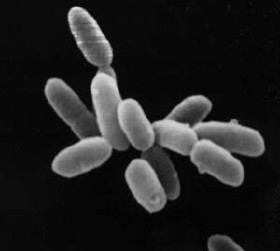Euryarchaeota
| Euryarchaeota | ||||||
|---|---|---|---|---|---|---|

Halobacterium sp. |
||||||
| Systematics | ||||||
|
||||||
| Scientific name | ||||||
| Euryarchaeota | ||||||
| Woese & Kandler & Wheelis , 1990 | ||||||
| Classes | ||||||
|
(see text) |
The Euryarchaeota (from the Greek euryos, variety) are a division within the Archaea (Archaea).
Characteristic for the Euryarchaeota is the large number of groups that are adapted as extremophiles to extremely unfavorable habitats. These include both very heat-loving archaea ( hyperthermophiles ), acid-loving ( acidophilic thermoplasmates ) and salt-loving groups ( halophiles , which can also be anaerobic ) and methane-producing ( methanogens ). Another large group within the Euryarchaeota are the marine Euryarchaeota living at sea.
Systematics
The currently accepted nomenclature is based on the LPSN ( List of Prokaryotic names with Standing in Nomenclature and NCBI ( National Center for Biotechnology Information ) based on analysis of the 16S rRNA .
-
Methanobacteria Boone 2002
- Methanobacteriales Bach and Wolfe 1981
-
Methanococci Boone 2002
- Methanococcales
- Halobacteria Grant et al. 2002
- Thermoplasmata Reysenbach 2002
- Thermococci Zillig and Reysenbach 2002
-
Archaeoglobi Garrity and Holt 2002
- Archaeoglobales
- Archaeoglobaceae
-
Methanopyri Garrity and Holt 2002
- Methanopyrales
- Methanopyraceae
- Methanopyrales
- " Methanomicrobia "
- Methanocellales
- Methanomicrobiales
- Methanosarcinales
- Hadesarchaea Baker et al. 2015
- " Methanonatronarchaeia " Sorokin et al. 2017
- " Theionarchaea " Lazar et al. 2017 (partially prescribed as Theinoarchaea)
| Euryarchaeota |
|
|||||||||||||||||||||||||||||||||||||||||||||||||||||||||
|
|
Note:
♠ Taxon only at NCBI, not on the LPSN. The Hadesarchaea are alternatively listed as an independent phylum Hadesarchaeota. The Nanohaloarchaea are alternatively assigned as Nanohaloarchaeota of the Archaean supergroup DPANN , a sister taxon of the Euryarchaeota.
Euryarchaeota cladogram according to Spang et al. (2017)
| Euryarchaeota |
|
|||||||||||||||||||||||||||||||||||||||||||||||||||||||||||||||||||||||||||||||||||||||||||||||||||||||||
|
|
Note: Classification of marine archaea
Marine archaa can be classified as follows:
- Marine Group I (MG-I or MGI): marine Thaumarchaeota with subgroups Ia (alias Ia) to Id
-
Marine Group II (MG-II): marine Euryarchaeota, order Poseidoniales (alias Poseidoniia / Thalassoarchaea) with subgroups IIa to IId (IIa corresponds to Poseidoniaceae , IIb corresponds to Thalassarchaceae )
Viruses that parasitize MGII are called Magroviruses . - Marine Group III (MG-III): alias Marine Benthic Group D (MBG-D), also marine Euryarchaeota
- Marine Group IV (MG-IV): also marine Euryarchaeota
Web links
- Website of the Institute for Microbiology and Molecular Biology at the University of Giessen
- Springer Link Encyclopedia of Astrobiology
- Spektrum.de Lexicon of Biology
- Alon Philosof, Natalya Yutin, José Flores-Uribe, Itai Sharon, Eugene V. Koonin, Oded Béjà: Novel Abundant Oceanic Viruses of Uncultured Marine Group II Euryarchaeota , in: Curr Biol. 27 (9) of May 8, 2017, p. 1362–1368, doi: 10.1016 / j.cub.2017.03.052 , PMC 5434244 (free full text), PMID 28457865 - the marine group I (MG-I), on the other hand, denotes marine archaea of the Thaumarchaeota , see also bacteriophages§Magroviruses
Individual evidence
- ↑ C. Schleper, G. Jurgens, M. Jonuscheit M: Genomic studies of uncultivated archaea . In: Nat Rev Microbiol . 3, No. 6, 2005, pp. 479-88. doi : 10.1038 / nrmicro1159 . PMID 15931166 .
- ^ JP Euzéby: Euryarchaeota . List of Prokaryotic names with Standing in Nomenclature ) (LPSN). Retrieved August 9, 2017.
- ^ Sayers: Euryarchaeota . National Center for Biotechnology Information (NCBI) taxonomy database. Retrieved August 9, 2017.
- ↑ 16S rRNA-based LTP release 121 (full tree) . Silva Comprehensive Ribosomal RNA Database . Archived from the original on September 23, 2015. Info: The archive link was inserted automatically and has not yet been checked. Please check the original and archive link according to the instructions and then remove this notice. Retrieved August 9, 2017.
- ↑ a b Anja Spang, Eva F. Caceres, Thijs JG Ettema: Genomic exploration of the diversity, ecology, and evolution of the archaeal domain of life , in: Science Volume 357 No. 6351, eaaf3883, August 11, 2017, doi: 10.1126 / science.aaf3883
- ↑ Catherine Badel, Gaël Erauso, Annika L. Gomez, Ryan Catchpole, Mathieu Gonnet, Jacques Oberto, Patrick Forterre, Violette Da Cunha: The global distribution and evolutionary history of the pT26-2 archaeal plasmid family , in: environmental microbiology, sfam, September 10, 2019, doi: 10.1111 / 1462-2920.14800
- ↑ Yinzhao Wang, Gunter Wegener, Jialin Hou, Fengping Wang, Xiang Xiao. Expanding anaerobic alkane metabolism in the domain of Archaea , in: Nature Microbiologyvolume 4, pp. 595-602, from March 4, 2019, doi: 10.1038 / s41564-019-0364-2
- ↑ Fengping Wang: Behind the paper: Expanding anaerobic alkane metabolism in the domain of Archaea , in: Nature Microbiology (Contributor), March 4, 2019
- ↑ Romano Mwirichia, Intikhab Alam, Mamoon Rashid, Vinu Manikandan, Wail Ba alawi, Allan Kamau, David Ngugi, Markus Göker, Hans-Peter Klenk, Vladimir Bajic, Uli Stingl: Metabolic traits of an uncultured archaeal lineage -MSBL1- from brine pools of the Red Sea , in: Scientific Reports 6 (19181), January 2016, doi: 10.1038 / srep19181
- ↑ Bjorn Carey: Wild Things: The Most Extreme Creatures , on: LiveScience, February 7, 2015
- ↑ Zhichao Zhou, Yang Liu, Karen G. Lloyd, Jie Pan, Yuchun Yang, Ji-Dong Gu, Meng Li: Genomic and transcriptomic insights into the ecology and metabolism of benthic archaeal cosmopolitan, Thermoprofundales (MBG-D archaea) , in: The ISME Journal, Volume 13 (2019), pp. 885-901, December 4, 2018, doi: 10.1038 / s41396-018-0321-8
- ↑ Julia M. Kurth, Nadine T. Smit, Stefanie Berger, Stefan Schouten, Mike S. M. Jetten, Cornelia U. Welte: Anaerobic methanotrophic archaea of the ANME-2d clade feature lipid composition that differs from other ANME archaea , in: FEMS Microbiology Ecology , Volume 95, No. May / July 2019, fiz082, doi: 10.1093 / femsec / fiz082
- ↑ Luis H. Orellana, T. Ben Francis, Karen Krüger, Hanno Teeling, Marie-Caroline Müller, Bernhard M. Fuchs, Konstantinos T. Konstantinidis, Rudolf I. Amann: Niche differentiation among annually recurrent coastal Marine Group II Euryarchaeota . In: The ISME Journal . 13, No. 12, 2019, pp. 3024-3036. doi : 10.1038 / s41396-019-0491-z . PMID 31447484 . PMC 6864105 (free full text).
- ↑ See in particular Fig. 4 in Yosuke Nishimura, Hiroyasu Watai, Takashi Honda, Tomoko Mihara, Kimiho Omae, Simon Roux, Romain Blanc-Mathieu, Keigo Yamamoto, Pascal Hingamp, Yoshihiko Sako, Matthew B. Sullivan, Susumu Goto, Hiroyuki Ogata , Takashi Yoshida: Environmental Viral Genomes Shed New Light on Virus-Host Interactions in the Ocean . In: mSphere . 2, No. 2, 2017. doi : 10.1128 / mSphere.00359-16 . PMID 28261669 . PMC 5332604 (free full text).
- ↑ Alon Philosof, Natalya Yutin, José Flores-Uribe, Itai Sharon, Eugene V. Koonin, Oded Béjà: Novel Abundant Oceanic Viruses of Uncultured Marine Group II Euryarchaeota . In: Current Biology . 27, No. 9, 2017, pp. 1362–1368. doi : 10.1016 / j.cub.2017.03.052 . PMID 28457865 . PMC 5434244 (free full text).
- ↑ Xiaomin Xia, Wang Guo, Hongbin Liu: Basin Scale Variation on the Composition and Diversity of Archaea in the Pacific Ocean . In: Frontiers in Microbiology . 8, 2017, p. 2057. doi : 10.3389 / fmicb.2017.02057 . PMID 29109713 . PMC 5660102 (free full text).
- ↑ Ana-Belen Martin-Cuadrado, Inmaculada Garcia-Heredia, Aitor Gonzaga Moltó, Rebeca López-Úbeda, Nikole Kimes, Purificación López-García, David Moreira, Francisco Rodriguez-Valera: A new class of marine Euryarchaeota group II from the mediterranean deep chlorophyll maximum . In: The ISME Journal . 9, No. 7, 2015, pp. 1619–1634. doi : 10.1038 / ismej.2014.249 . PMID 25535935 . PMC 4478702 (free full text).
- ↑ NCBI: Candidatus Poseidoniales (order)
- ^ NCBI: Marine Group III
- ^ NCBI: Marine Group IV
